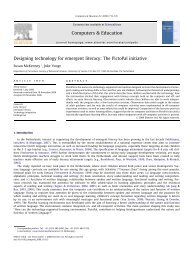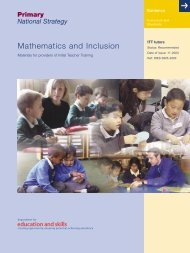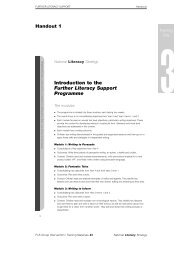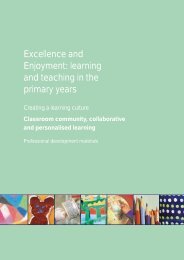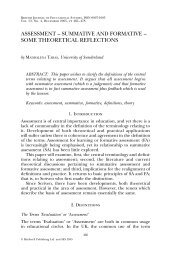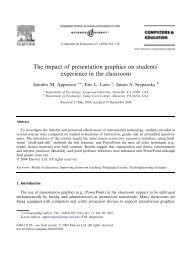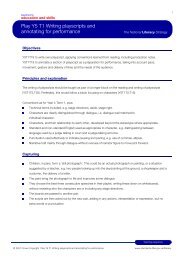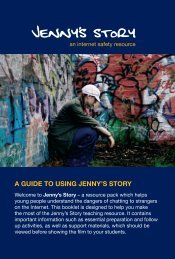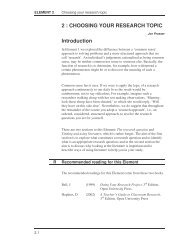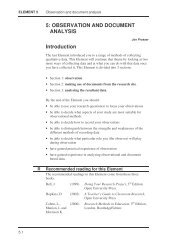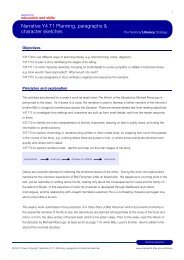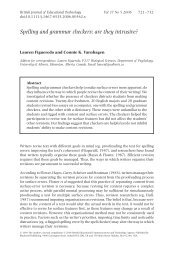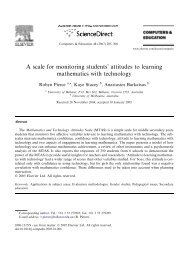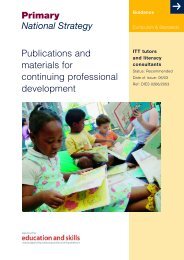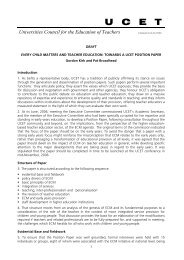everything you wanted to know about questionnaires but ... - PGCE
everything you wanted to know about questionnaires but ... - PGCE
everything you wanted to know about questionnaires but ... - PGCE
Create successful ePaper yourself
Turn your PDF publications into a flip-book with our unique Google optimized e-Paper software.
Questionnaires<br />
23/12/2009 07:06<br />
EVERYTHING YOU WANTED TO KNOW ABOUT<br />
QUESTIONNAIRES BUT WERE AFRAID TO ASK<br />
1993 © David S. Walonick, Ph.D.<br />
Questionnaires are one of the most popular methods of conducting scholarly research. They<br />
provide a convenient way of gathering information from a target population.<br />
This paper will address most of the important issues related <strong>to</strong> written <strong>questionnaires</strong><br />
Advantages and Disadvantages of Written Questionnaires<br />
Questionnaires are easy <strong>to</strong> analyze, and most statistical analysis software can easily process<br />
them. They are cost effective when compared <strong>to</strong> face-<strong>to</strong>-face interviews, mostly because of<br />
the costs associated with travel time (Bachrack and Scoble, 1967; Benson, 1946; Hochstim<br />
and Athanasopoulos, 1970; Moser and Kal<strong>to</strong>n, 1971; Seitz, 1944). This is especially true for<br />
studies involving large sample sizes and large geographic areas (Clausen and Ford, 1947;<br />
Goode and Hatt, 1962; Ruckmick, 1930). Written <strong>questionnaires</strong> become even more cost<br />
effective as the number of research questions increases.<br />
Questionnaires are familiar <strong>to</strong> most people (Berdie, Anderson, and Niebuhr, 1986). Nearly<br />
everyone has had some experience completing <strong>questionnaires</strong> and they generally do not make<br />
people apprehensive. They are less intrusive than telephone or face-<strong>to</strong>-face surveys. When<br />
respondents receive a questionnaire in the mail, they are free <strong>to</strong> complete it on their own timetable<br />
(Cahalan, 1951; Jahoda, et al., 1962). Unlike other research methods, the respondent is<br />
not interrupted by the research instrument. On the other hand, <strong>questionnaires</strong> are simply not<br />
suited for some people. For example, a written survey <strong>to</strong> a group of poorly educated people<br />
might not work because of reading skill problems. More frequently, some people are turned off<br />
by written <strong>questionnaires</strong> because of misuse (Deutcher, 1956; Nor<strong>to</strong>n, 1930).<br />
Written <strong>questionnaires</strong> reduce interviewer bias because there is uniform question presentation<br />
(Jahoda, et al., 1962). Unlike in-person interviewing, there are no verbal or visual clues <strong>to</strong><br />
influence a respondent <strong>to</strong> answer in a particular way. Many investiga<strong>to</strong>rs have reported that<br />
interviewer voice inflections and mannerisms can bias responses (Barath and Cannell, 1976;<br />
Benson, 1946; Boyd and Westfall, 1965, 1970; Cahalan, 1951; Collins, 1970; Dohrenwend,<br />
Colombo<strong>to</strong>s, and Dohrenwend, 1968; Franzen and Lazersfeld, 1945). Written surveys are not<br />
subject <strong>to</strong> this bias because there is no interviewer. On the other hand, the lack of an<br />
interviewer limits the researcher's ability <strong>to</strong> probe responses. Structured <strong>questionnaires</strong> often<br />
lose the "flavor of the response", because respondents often want <strong>to</strong> qualify their answers<br />
(Walonick, 1993). By allowing frequent space for comments, the researcher can partially<br />
overcome this disadvantage.<br />
A common criticism of mail surveys is that they often have low response rates (Benson, 1946;<br />
Phillips, 1941; Robinson, 1952). Low response is the curse of statistical analysis, and it can<br />
dramatically lower confidence in the results. While response rates vary widely from one<br />
questionnaire <strong>to</strong> another, well-designed studies consistently produce high response rates.<br />
When returned <strong>questionnaires</strong> arrive in the mail, it's natural <strong>to</strong> assume that the respondent is<br />
the same person <strong>you</strong> sent the questionnaire <strong>to</strong>. A number of researchers have reported that<br />
this may not actually be the case (Clausen and Ford, 1947; Franzen and Lazersfeld, 1945;<br />
Moser and Kal<strong>to</strong>n, 1971; Scott, 1961). Many times business <strong>questionnaires</strong> get handed <strong>to</strong><br />
other employees for completion. Housewives sometimes respond for their husbands. Kids<br />
http://www.statpac.com/research-papers/<strong>questionnaires</strong>.htm<br />
Page 1 of 19
Questionnaires<br />
23/12/2009 07:06<br />
respond as a prank. For a variety of reasons, the respondent may not be who <strong>you</strong> think it is.<br />
In a summary of five studies sponsored by the British Government, Scott (1961) reports that<br />
up <strong>to</strong> ten percent of the returned <strong>questionnaires</strong> had been completed by someone other than<br />
the intended person.<br />
Response Rate<br />
Response rate is the single most important indica<strong>to</strong>r of how much confidence can be placed in<br />
the results of a mail survey. A low response rate can be devastating <strong>to</strong> the reliability of a study<br />
(Benson, 1946; Phillips, 1941; Robinson, 1952). Fortunately, "low response rates are not an<br />
inherent shortcoming of mail surveys", and the researcher must do <strong>everything</strong> possible <strong>to</strong><br />
maximize response (Berdie, Anderson, and Neibuhr, 1986, p. 17). Much of the research in<br />
questionnaire methodology has centered around techniques <strong>to</strong> maximize response. However,<br />
Jones and Lang (1980) point out that increasing the response rate does not necessarily<br />
improve the precision of survey results.<br />
Following up on Nonrespondents<br />
One of the most powerful <strong>to</strong>ol for increasing response is <strong>to</strong> use follow-ups or reminders (Scott,<br />
1961; Toops, 1924). "Traditionally, between 5 and 65 percent of those sent <strong>questionnaires</strong><br />
respond without follow-up reminders. These rates are <strong>to</strong>o low <strong>to</strong> yield confident results"<br />
(Berdie, Anderson, and Niebuhr, 1986, p. 58). The need <strong>to</strong> follow up on nonrespondents is<br />
clear.<br />
Researchers can increase the response from follow-up attempts by including another copy of<br />
the questionnaire (Futrell and Lamb, 1981; Goldstein and Kroll, 1957; Orr and Neyman, 1965;<br />
Sivan, Epley, and Burns, 1980). The most important consideration is that the investiga<strong>to</strong>r<br />
"designs the follow-up procedure by taking in<strong>to</strong> consideration the unique characteristics of the<br />
people in the sample." (Berdie, Anderson, and Neibuhr, 1986, p. 58) The most successful<br />
follow-ups have been achieved by phone calls (Roscoe, Lang, and Sheth, 1975; Sheth and<br />
Roscoe, 1975; Speer and Zold, 1971).<br />
Many researchers have examined whether postcard follow-ups are effective in increasing<br />
response (Cox, Anderson. and Fulcher, 1974; Hinrichs, 1975; Jones and Lang, 1980; Keane,<br />
1963; Peterson, 1975; Watson, 1965; Wiseman, 1973). The vast majority of these studies<br />
show that a follow-up postcard increases response rate, and a meta-analysis by Fox, Crask,<br />
and Kim (1988) reveals an aggregate gain of 3.5 percent. The postcard serves as an effective<br />
reminder for subjects who have forgotten <strong>to</strong> complete the survey (Dillman, 1978).<br />
Nonresponse Bias<br />
Many studies have attempted <strong>to</strong> determine if there is a difference between respondents and<br />
nonrespondents. Some researchers have reported that people who respond <strong>to</strong> surveys answer<br />
questions differently than those who do not (Benson, Booman, and Clark, 1951; Gough and<br />
Hall, 1977). Others have found that late responders answer differently than early responders,<br />
and that the differences may be due <strong>to</strong> the different levels of interest in the subject matter<br />
(Bauer, 1947; Brown and Wilkins, 1978; Reid, 1942; Speer and Zold, 1971). One researcher,<br />
who examined a volunteer organization, reported that those more actively involved in the<br />
organization were more likely <strong>to</strong> respond (Donald, 1960).<br />
Demographic characteristics of nonrespondents have been investigated by many researchers.<br />
Most studies have found that nonresponse is associated with low education (Gannon,<br />
Northern, and Carrol, 1971; Robins, 1963; Suchman and McCandless, 1940). However, one<br />
reseacher (Bar<strong>to</strong>n, 1980) reported that demographic characteristics such as age, education,<br />
and employment status were the same for respondents and nonrespondents. Another study<br />
found that nonrespondents were more often single males (Gannon, Northern, and Carrol,<br />
1971).<br />
Most researchers view nonresponse bias as a continuum, ranging from fast responders <strong>to</strong><br />
slow responders (with nonresponders defining the end of the continuum). In fact, one study<br />
used extrapolation <strong>to</strong> estimate the magnitude of bias created by nonresponse (Armstrong and<br />
Over<strong>to</strong>n, 1977). Another group of researchers argue that nonresponse should not be viewed<br />
as a continuum, and "that late respondents do not provide a suitable basis for estimating the<br />
characteristics of nonrespondents" (Ellis, Endo, and Armer, 1970).<br />
http://www.statpac.com/research-papers/<strong>questionnaires</strong>.htm<br />
Page 2 of 19
Questionnaires<br />
23/12/2009 07:06<br />
Goal Definition<br />
Most problems with <strong>questionnaires</strong> can be traced back <strong>to</strong> the design phase of the project.<br />
Well-defined goals are the best way <strong>to</strong> assure a good questionnaire design (Bartholomew,<br />
1963; Freed, 1964). One of the best ways <strong>to</strong> clarify the study goals is <strong>to</strong> decide how the<br />
information will be used. (Berdie, Anderson, and Niebuhr, 1986; Oppenheim, 1966; Payne,<br />
1951). Study goals should be committed <strong>to</strong> writing (Freed, 1964). When the goals of a study<br />
can be expressed in a few clear and concise sentences, the design of the questionnaire<br />
becomes considerably easier. The questionnaire is developed <strong>to</strong> directly address the goals of<br />
the study.<br />
One important way <strong>to</strong> assure a successful survey is <strong>to</strong> include other experts and relevant<br />
decision-makers in the questionnaire design process (Walonick, 1993). Their suggestions will<br />
improve the questionnaire and they will subsequently have more confidence in the results.<br />
General La<strong>you</strong>t and Format Considerations<br />
The physical appearance of a written survey may largely determine if the respondent will<br />
return it (Levine and Gordon, 1958). Therefore, it is important <strong>to</strong> use professional production<br />
methods for the questionnaire--either desk<strong>to</strong>p publishing or typesetting and keylining<br />
(Robinson and Agisim, 1951; Robinson, 1952; Slet<strong>to</strong>, 1940; Toops, 1937).<br />
Every questionnaire should have a title that is short and meaningful <strong>to</strong> the respondent (Berdie,<br />
Anderson, and Niebuhr, 1986). The rationale is that a questionnaire with a title will be<br />
perceived as more credible than one without.<br />
Well-designed <strong>questionnaires</strong> include clear and concise instructions on how they should be<br />
completed. These must be very easy <strong>to</strong> understand, so use short sentences and basic<br />
vocabulary. The questionnaire itself should have the return address printed on it since<br />
<strong>questionnaires</strong> often get separated from the reply envelopes (Berdie, Anderson, and Niebuhr,<br />
1986).<br />
Questionnaires should use simple and direct language (Nor<strong>to</strong>n, 1930). The questions must be<br />
clearly unders<strong>to</strong>od by the respondent, and have the same meaning that the researcher<br />
intended (Freed, 1964; Huffman, 1948). The wording of a question should be simple, <strong>to</strong> the<br />
point, and familiar <strong>to</strong> the target population (Freed, 1964; Moser and Kal<strong>to</strong>n, 1971). Surprisingly,<br />
several researchers (Blair et al., 1977; Laurent, 1972) have found that longer questions elicit<br />
more information than shorter ones, and that the information tends <strong>to</strong> be more accurate.<br />
However, it is generally accepted that questionnaire items should be simply stated and as brief<br />
as possible (Payne, 1951). The rationale is that this will reduce misunderstandings and make<br />
the questionnaire appear easier <strong>to</strong> complete. One way <strong>to</strong> eliminate misunderstandings is <strong>to</strong><br />
emphasize crucial words in each item by using bold, italics or underlining (Berdie, Anderson,<br />
Niebuhr, 1986).<br />
Uncommon words, jargon, and abbreviations may be included in a questionnaire provided that<br />
they are familiar <strong>to</strong> the population being investigated (Bartholomew, 1963). Slang is often<br />
ambiguous, and should be excluded from all <strong>questionnaires</strong> (Payne, 1951).<br />
Questionnaires should leave adequate space for respondents <strong>to</strong> make comments. One<br />
criticism of <strong>questionnaires</strong> is their inability <strong>to</strong> retain the "flavor" of a response. Leaving space<br />
for comments will provide valuable information not captured by the response categories.<br />
Leaving white space also makes the questionnaire look easier and this might increase<br />
response (Berdie, Anderson, and Neibuhr, 1986).<br />
Researchers should design the questionnaire so it holds the respondent's interest. The goal is<br />
<strong>to</strong> make the respondent want <strong>to</strong> complete the questionnaire. One way <strong>to</strong> keep a questionnaire<br />
interesting is <strong>to</strong> provide variety in the type of items used. Varying the questioning format will<br />
also prevent respondents from falling in<strong>to</strong> "response sets".<br />
If a questionnaire is more than a few pages and is held <strong>to</strong>gether by a staple, include some<br />
identifying data on each page (such as a respondent ID number). Pages often accidentally<br />
separate (Berdie, Anderson, and Neibuhr, 1986).<br />
The Order of the Questions<br />
Questionnaires should begin with a few non-threatening and easy <strong>to</strong> answer items (Erdos,<br />
http://www.statpac.com/research-papers/<strong>questionnaires</strong>.htm<br />
Page 3 of 19
Questionnaires<br />
23/12/2009 07:06<br />
1957; Robinson, 1952; Slet<strong>to</strong>, 1940). If the first items are <strong>to</strong>o difficult or threatening, there is<br />
little chance that the person will complete the questionnaire (Levine and Gordon, 1958).<br />
People generally look at the first few questions before deciding whether or not <strong>to</strong> complete the<br />
questionnaire. The researcher can encourage response by starting with a few interesting and<br />
nonthreatening questions.<br />
Likewise, the most important items should appear in the first half of the questionnaire (Levine<br />
and Gordon, 1958). Respondents often send back partially completed <strong>questionnaires</strong>. By<br />
putting the most important items near the beginning, the partially completed <strong>questionnaires</strong><br />
will still contain important information.<br />
Items on a questionnaire should be grouped in<strong>to</strong> logically coherent sections (Levine and<br />
Gordon, 1958; Robinson, 1952; Seitz, 1944). Grouping questions that are similar will make the<br />
questionnaire easier <strong>to</strong> complete, and the respondent will feel more comfortable. Questions<br />
that use the same response formats, or those that cover a specific <strong>to</strong>pic, should appear<br />
<strong>to</strong>gether (Freed, 1964).<br />
Each question should follow comfortably from the previous question. Writing a questionnaire is<br />
similar <strong>to</strong> writing anything else. Transitions between questions should be smooth.<br />
Questionnaires that jump from one unrelated <strong>to</strong>pic <strong>to</strong> another feel disjointed and are not likely<br />
<strong>to</strong> produce high response rates.<br />
Most investiga<strong>to</strong>rs have found that the order in which questions are presented can affect the<br />
way that people respond (Noelle-Newmann, 1970; Schuman and Presser, 1981; Smith, 1982;<br />
Sudman, Seymour, and Bradburn, 1974; Tourangeau and Rasinski, 1988). One study reported<br />
that questions in the latter half a questionnaire were more likely <strong>to</strong> be omitted, and contained<br />
fewer extreme responses (Kraut, Wolfson, and Rothenberg, 1975). Carp (1974) suggested that<br />
it may be necessary <strong>to</strong> prevent general questions before specific ones in order <strong>to</strong> avoid<br />
response contamination. McFarland (1981) reported that when specific questions were asked<br />
before general questions, respondents tended <strong>to</strong> exhibit greater interest in the general<br />
questions.<br />
A few researchers, however, have found that question-order does not effect responses.<br />
Bradburn and Mason (1964) reported that interviews involving self-reports and self-evaluations<br />
were unaffected by question order. Clancey and Wachsler (1971) found that responses <strong>to</strong><br />
questions were similar regardless of where the questions appeared in a questionnaire. Bishop<br />
et al. (1988) reported that question-order effects existed in interviews, <strong>but</strong> not in written<br />
surveys. Ayidiya and McClendon (1990) reported mixed results, where some questions were<br />
subject <strong>to</strong> order effects, and other similar questions were not.<br />
Anonymity and Confidentiality<br />
"An anonymous study is one in which nobody (not even the study direc<strong>to</strong>rs) can identify who<br />
provided data on completed <strong>questionnaires</strong>." (Berdie, Anderson, Niebuhr, 1986, p. 47) It is<br />
generally not possible <strong>to</strong> conduct an anonymous questionnaire through the mail because of<br />
the need <strong>to</strong> follow-up on nonresponders. However, it is possible <strong>to</strong> guarantee confidentiality,<br />
where the those conducting the study promise not <strong>to</strong> reveal the information <strong>to</strong> anyone. For the<br />
purpose of follow-up, identifying numbers on <strong>questionnaires</strong> are generally preferred <strong>to</strong> using<br />
respondents' names. It is important, however, <strong>to</strong> explain why the number is there and what it<br />
will be used for.<br />
Some studies have shown that response rate is affected by the anonymity/confidentiality policy<br />
of a study (Jones, 1979; Dickson et al., 1977; Epperson and Peck, 1977). Klein, Maher, and<br />
Dunning<strong>to</strong>n (1967) reported that responses became more dis<strong>to</strong>rted when subjects felt<br />
threatened that their identities would become <strong>know</strong>n. Others have found that<br />
anonymity/confidentiality issues do not affect response rates or responses (Butler, 1973; Fuller,<br />
1974; Futrell and Swan, 1977; Skinner and Childers, 1980; Watkins, 1978; Wildman, 1977).<br />
One researcher reported that the lack of anonymity actually increased response (Fuller, 1974).<br />
The Length of a Questionnaire<br />
As a general rule, long <strong>questionnaires</strong> get less response than short <strong>questionnaires</strong> (Brown,<br />
1965; Leslie, 1970). However, some studies have shown that the length of a questionnaire<br />
does not necessarily affect response (Berdie, 1973; Champion and Sear, 1979; Childers and<br />
Ferrell, 1979; Duncan, 1979; Layne and Thompson, 1981; Mason Dressel, and Bain, 1961).<br />
http://www.statpac.com/research-papers/<strong>questionnaires</strong>.htm<br />
Page 4 of 19
Questionnaires<br />
23/12/2009 07:06<br />
"Seemingly more important than length is question content." (Berdie, Anderson, and Niebuhr,<br />
1986, p. 53) A subject is more likely <strong>to</strong> respond if they are involved and interested in the<br />
research <strong>to</strong>pic (Bauer, 1947; Brown and Wilkins, 1978; Reid, 1942; Speer and Zold, 1971).<br />
Questions should be meaningful and interesting <strong>to</strong> the respondent.<br />
Color of the Paper<br />
One study found that the color of the paper (yellow, pink, and white) did not have an effect on<br />
response (Sharma and Singh, 1967). Nevertheless, Berdie, Anderson and Neibuhr (1986)<br />
suggest that color might make the survey more appealing. Another early study examined the<br />
ink and paper color combinations that provide the greatest legibility (Paterson and Tinker,<br />
1940). The authors suggest three different ink colors for white paper: black, grass green, and<br />
lustre blue. The only other recommended combination is black ink on yellow paper.<br />
Some investiga<strong>to</strong>rs have examined the effect of using a green paper compared <strong>to</strong> white paper.<br />
Two studies (Gullahorn and Gullahorn, 1963; Pressley and Tullar, 1977) reported no significant<br />
differences in response rates, while another (Pucel, Nelson and Wheeler, 1971) reported a 9.1<br />
percent difference. A meta-analysis of these studies calculated an average aggregate increase<br />
of 2.0 percent when using a green questionnaire (Fox, Crask, and Kim, 1988).<br />
Incentives<br />
Many researchers have examined the effect of providing a variety of nonmonetary incentives<br />
<strong>to</strong> subjects. These include <strong>to</strong>ken gifts such as small packages of coffee, ball-point pens,<br />
postage stamps, or key rings (Nederhof, 1983; Pucel, Nelson, and Wheeler, 1971; Whitmore,<br />
1976), trading stamps (Brennan, 1958), participation in a raffle or lottery (Knox, 1951; Blythe,<br />
1986), or a donation <strong>to</strong> a charity in the respondent's name (Furse and Stewart, 1982; Hubbard<br />
and Little, 1987; Robertson and Bellenger, 1978). Generally (although not consistently),<br />
nonmonetary incentives have resulted in an increased response.<br />
There can be little doubt that monetary incentives increase response. Only a few investiga<strong>to</strong>rs<br />
have reported no increase in response (Dohrenwend, 1970; Landy and Bates, 1973). The<br />
overwhelming majority have reported increased response by including monetary incentives<br />
(Blumberg, Fuller, and Hare, 1974; Crowley, 1959; Ferber and Sudman, 1974; Friedman and<br />
Augustine, 1979; Furse and Stewart, 1982; Furse, Stewart and Rados, 1981; Godwin, 1979;<br />
Goodstadt, et al., 1977; Hackler and Bourgette, 1973; Hansen, 1980; Huck and Gleason,<br />
1974, James and Bolstein, 1990; Kimbal, 1961; McDaniel and Jackson, 1984; Newman, 1962;<br />
Pressley and Tullar, 1977; Robin and Walter, 1976; Watson, 1965; Wiseman, 1973; Wotruba,<br />
1966).<br />
Church (1993) conducted of meta-analysis of 38 prior studies that used some form of an<br />
incentive. Monetary and nonmonetary incentives were effective only when enclosed with the<br />
survey. The promise of an incentive for a returned questionnaire was not effective in<br />
increasing response. The average increase in response rate for monetary and nonmonetary<br />
incentives was 19.1 percent and 7.9 percent, respectively.<br />
Many researchers have found that higher monetary incentives generally work better than<br />
smaller ones (Armstrong, 1975; Chromy and Horvitz, 1978; Doob, Freedman, and Carlsmith,<br />
1973; Gunn and Rhodes, 1981; James and Bolstein, 1990; Linsky, 1975; Yu and Cooper,<br />
1983). Armstrong (1975) proposed a diminishing return model, where increasing the amount of<br />
the incentive would have a decreasing effect on response rate. A meta-analysis performed by<br />
Fox, Crask, and Kim (1988) applied Armstrong's diminishing return model <strong>to</strong> fifteen studies. An<br />
incentive of 25¢ increased the response rate by an average of 16 percent, and $1 increased<br />
the response by 31 percent.<br />
It is not <strong>know</strong>n whether the effects of incentives disappear after follow-up mailings. Kephart<br />
and Bressler (1958) found that a 25¢ incentive significantly increased response, however, the<br />
effect disappeared after one follow-up mailing. Another study using a 25¢ incentive<br />
(Goodstadt, et al., 1977) reported a significant difference, and the difference continued <strong>to</strong> be<br />
significant even after three follow-up mailings. James and Bolstein (1990) reported that four<br />
mailings without an incentive produced a better response than one mailing with an incentive.<br />
However, incentives of $1 and $2 with follow-ups produced a significantly better response<br />
than the same number of follow-ups with no incentive. Nederhof (1983) used a ball-point pen<br />
as an incentive and reported that "the effect of nonmonetary incentives on response rates<br />
disappears after the first mailing."<br />
http://www.statpac.com/research-papers/<strong>questionnaires</strong>.htm<br />
Page 5 of 19
Questionnaires<br />
23/12/2009 07:06<br />
It is not clear whether offering <strong>to</strong> share the results of the research provides sufficient incentive<br />
<strong>to</strong> affect response. Mullner, Levy, Byre, and Matthews (1982) report that mentioning the offer<br />
in a cover letter did not increase response, while two older studies found that it did (Koos,<br />
1928;, Wiseman, 1973).<br />
Notification of a Cu<strong>to</strong>ff Date<br />
Several researchers have examined the effect of giving subjects a deadline for responding<br />
(Duncan, 1979; Erdos, 1957; Ferriss, 1951; Jones and Lang, 1980; Jones and Linda, 1978;<br />
Nevin and Ford, 1976; Hous<strong>to</strong>n and Nevin, 1977; eterson, 1975; Vocino, 1977) While a<br />
deadline will usually reduce the time from the mailing until the returns begin arriving, it<br />
appears that it does not increase response, and may even reduce the response. One possible<br />
explanation is that a cu<strong>to</strong>ff date might dissuade procrastina<strong>to</strong>rs from completing the<br />
questionnaire after the deadline has past. A meta-analysis by Fox, Crask and Kim (1988)<br />
revealed an aggregate increase in response rate of 1.7 percent, which was not significant.<br />
Reply Envelopes and Postage<br />
A good questionnaire makes it convenient for the respondent <strong>to</strong> reply. Mail surveys that<br />
include a self-addressed stamped reply envelope get better response than business reply<br />
envelopes, although they are more expensive since <strong>you</strong> also pay for the non-respondents<br />
(Brook, 1978; Gullahorn and Gullahorn, 1963; Harris and Guffey, 1978; Jones and Linda,<br />
1978; Kimball, 1961; Martin and McConnell, 1970; McCrohan and Lowe, 1981; Peterson,<br />
1975, Price, 1950; Veiga, 1974; Watson, 1965; Wiseman, 1973). Some investiga<strong>to</strong>rs have<br />
suggested that people might feel obligated <strong>to</strong> complete the questionnaire because of the guilt<br />
associated with throwing away money--that is, the postage stamp (Moser, 1971; Scott, 1961).<br />
Others have pointed out that using a business reply permit might suggest advertising <strong>to</strong> some<br />
people (Goode and Hatt, 1962). Another possibility is that a business reply envelope might be<br />
perceived as less personal (Armstrong and Lusk, 1987).<br />
Armstrong and Lusk (1987) performed a meta-analysis on 34 studies comparing stamped<br />
versus business reply postage. They calculated that stamped reply envelopes had a 9 percent<br />
greater aggregate effect than business reply envelopes. In a subsequent meta-analysis on<br />
nine studies, Fox, Crask, and Kim (1988) reported an aggregate effect of 6.2 percent.<br />
The Outgoing Envelope and Postage<br />
There have been several researchers that examined whether there is a difference in response<br />
between first class postage versus bulk rate. (Brook, 1978; Gullahorn and Gullahorn, 1963;<br />
Kernan, 1971; McCrohan and Lowe, 1981; Watson, 1965). A meta-analysis of these studies<br />
(Fox, Crask, and Kim, 1988) revealed a small, <strong>but</strong> significant, aggregate difference of 1.8<br />
percent. Envelopes with bulk mail permits might be perceived as "junk mail", unimportant, or<br />
less personal (Armstrong and Lusk, 1987), and thus will be reflected in a lower response<br />
rates.<br />
A few researchers have also examined whether metered mail or stamps work better on the<br />
outgoing envelope (Dillman, 1972; Kernan, 1971; Peterson, 1975; Vocino, 1977). The results<br />
of these studies suggest a small increase in response favoring a stamped envelope. A metaanalysis<br />
of these studies (Fox, Crask, and Kim, 1988) revealed that the aggregate difference<br />
was slightly less than one percent.<br />
Many researchers have reported increased response rates by using registered, certified, or<br />
special delivery mail <strong>to</strong> send the questionnaire (Champion and Sear, 1969; Eckland, 1965;<br />
Eisinger, et al., 1974; Gullahorn and Gullahorn, 1959; House, Gerber, and McMichael, 1977;<br />
Tedin and Hofstetter, 1982). The wisdom of using these techniques must be weighed against<br />
the consequences of angering respondents that make a special trip <strong>to</strong> the post office, only <strong>to</strong><br />
find a questionnaire (Berdie, Anderson, and Niebuhr, 1986; Slocum and Swanson, 1956).<br />
It is not clear whether a typed or hand-addressed envelope would affect response. One study,<br />
conducted at the University of Minnesota, reported that students responded better <strong>to</strong> handaddressed<br />
postcards, while professors responded better <strong>to</strong> typed addresses (Anderson and<br />
Berdie, 1972).<br />
This researcher could find no studies that examined whether gummed labels would have a<br />
deleterious effect on response rate, although we might predict that response rate would be<br />
http://www.statpac.com/research-papers/<strong>questionnaires</strong>.htm<br />
Page 6 of 19
Questionnaires<br />
23/12/2009 07:06<br />
less for gummed labels because they have the appearance of less personalization.<br />
This researcher could also find no studies that examined whether the color of the envelope<br />
affects response rate. First impressions are important, and the respondent's first impression of<br />
the study usually comes from the envelope containing the survey. Therefore, we might predict<br />
that color would have a positive impact on response because of its uniqueness.<br />
The "Don't Know", "Undecided", and "Neutral" Response Options<br />
Response categories are developed for questions in order <strong>to</strong> facilitate the process of coding<br />
and analysis. Many studies have looked at the effects of presenting a "don't <strong>know</strong>" option in<br />
attitudinal questions (Bishop, Tuchfarber, and Oldendick, 1986; Bishop, Oldendick, and<br />
Tuchfarber, 1983, 1978; Bishop et al., 1980; Schuman and Presser, 1981, 1978). The "don't<br />
<strong>know</strong>" option allows respondents <strong>to</strong> state that they have no opinion or have not thought <strong>about</strong><br />
a particular issue (Poe et al., 1988).<br />
Holdaway (1971) found that the physical placement of the "undecided" category (at the<br />
midpoint of the scale, or separated from the scale) could change response patterns.<br />
Respondents were more likely <strong>to</strong> choose the "undecided" category when it was off <strong>to</strong> the side<br />
of the scale. This study also reported different response patterns depending on whether the<br />
midpoint was labeled "undecided" or "neutral".<br />
Bishop (1987) also found that the physical location of the middle alternative can make a<br />
difference in responses, and that placing the middle option at the last position in the question<br />
increased the percentage of respondents who selected it by over 9 percent. Bishop states that<br />
"offering respondents a middle alternative in a survey question will generally make a<br />
significant difference in the conclusions that would be drawn [from the data]." The middle<br />
option of an attitudinal scale attracts a substantial number of respondents who might be<br />
unsure of their opinion.<br />
Poe et al. (1988) studied the "don't <strong>know</strong>" option for factual questions. Unlike attitude<br />
questions, respondents might legitimately not <strong>know</strong> the answer <strong>to</strong> a factual question. Their<br />
findings suggest that the "don't <strong>know</strong>" option should not be included in factual questions.<br />
Questions that excluded the "don't <strong>know</strong>" option produced a greater volume of accurate data.<br />
They found no difference in response rate depending on the inclusion or exclusion of the<br />
"don't <strong>know</strong>" option. Poe's finding directly contradict several previous authors who advocate<br />
including a "don't <strong>know</strong>" response category when there is any possibility that the respondent<br />
may not <strong>know</strong> the answer <strong>to</strong> a question (Bartholomew, 1963; Jahoda, Deutsch, and Cook,<br />
1962; Payne, 1951).<br />
Question Wording<br />
The wording of a question is extremely important. Researchers strive for objectivity in surveys<br />
and, therefore, must be careful not <strong>to</strong> lead the respondent in<strong>to</strong> giving the answer a desired<br />
answer. Unfortunately, the effects of question wording are one of the least unders<strong>to</strong>od areas<br />
of questionnaire research.<br />
Many investiga<strong>to</strong>rs have confirmed that slight changes in the way questions are worded can<br />
have a significant impact on how people respond (Arndt and Crane, 1975; Belkin and<br />
Lieverman, 1967; Cantril, 1944; Kal<strong>to</strong>n, Collins, and Brook, 1978; Petty, Rennier and<br />
Cacioppo, 198; Rasinski, 1989; Schuman and Presser, 1981, 1977; ). Several authors have<br />
reported that minor changes in question wording can produce more than a 25 percent<br />
difference in people's opinions (Payne, 1951; Rasinski, 1989).<br />
One important area of question wording is the effect of the interrogation and assertion<br />
question formats. The interrogation format asks a question directly, where the assertion format<br />
asks subjects <strong>to</strong> indicate their level of agreement or disagreement with a statement. Schuman<br />
and Presser (1981) reported no significant differences between the two formats, however,<br />
other researchers hypothesized that the interrogation format is more likely <strong>to</strong> encourage<br />
subjects <strong>to</strong> think <strong>about</strong> their answers (Burnkrant and Howard, 1984; Petty, Cacioppo, and<br />
Heesacker, 1981; Swasy and Munch, 1985; Zillman, 1972). Petty, Rennier and Cacioppo<br />
(1987) found that the interrogation format caused greater polarization in subjects' responses,<br />
suggesting that there was greater cognition than the assertion format.<br />
Other investiga<strong>to</strong>rs have looked at the effects of modifying adjectives and adverbs (Bradburn<br />
http://www.statpac.com/research-papers/<strong>questionnaires</strong>.htm<br />
Page 7 of 19
Questionnaires<br />
23/12/2009 07:06<br />
and Miles, 1979; Hoyt, 1972; Schaeffer, 1991). Words like usually, often, sometimes,<br />
occasionally, seldom, and rarely are "commonly" used in <strong>questionnaires</strong>, although it is clear<br />
that they do not mean the same thing <strong>to</strong> all people. Simpson (1944), and a replication by<br />
Hakel (1968), looked at twenty modifying adjectives and adverbs. These researchers found<br />
that the precise meanings of these words varied widely between subjects, and between the<br />
two studies. However, the correlation between the two studies with respect <strong>to</strong> the relative<br />
ranking of the words was .99.<br />
John Hoyt (1972) conducted a study on how people interpret quantifying adjectives. The<br />
results show that some of the adjectives had high variability and others had low variability. The<br />
following adjectives were found <strong>to</strong> have highly variable meanings: a clear mandate, most,<br />
numerous, a substantial majority, a minority of, a large proportion of, a significant number of,<br />
many, a considerable number of, and several. Other adjectives produced less variability and<br />
generally had shared meaning. These were: lots, almost all, virtually all, nearly all, a majority<br />
of, a consensus of, a small number of, not very many of, almost none, a damn few, hardly<br />
any, a couple, and a few.<br />
Sponsorship<br />
There have been several studies <strong>to</strong> determine if the sponsor of a survey might affect response<br />
rate (Houstan and Nevin, 1977; Jones and Lang, 1980; Jones and Linda, 1978; Peterson,<br />
1975). The overwhelming majority of these studies have clearly demonstrated that university<br />
sponsorship is the most effective. A meta-analysis of these studies revealed an aggregate<br />
increase in response rate of 8.9 percent (Fox, Crask and Kim, 1988). Dillman (1978)<br />
suggested that this may be due <strong>to</strong> the past benefits that the respondent has received from the<br />
university. Another possibility is that a business sponsor implies advertising or sales <strong>to</strong><br />
potential respondents.<br />
Prenotification Letters<br />
Many researchers have studied prenotification letters <strong>to</strong> determine if they increase response<br />
rate (Ford, 1968; Hea<strong>to</strong>n, 1965; Heberlein and Baumgartner, 1978; Jones and Lang, 1980;<br />
Myers and Haug, 1969; Parson and Medford, 1972; Pucel, Nelson and Wheeler, 1971;<br />
Stafford, 1966; Walker and Burdick, 1977). A meta-analysis of these studies revealed an<br />
aggregate increase in response rate of 7.7 percent (Fox, Crask and Kim, 1988). Dillman<br />
(1978) proposed that prenotification letters might help <strong>to</strong> establish the legitimacy of a survey,<br />
thereby contri<strong>but</strong>ing <strong>to</strong> a respondent's trust. Another possibility is that a prenotification letter<br />
builds expectation, and reduces the possibility that a potential respondent might disregard the<br />
survey when it arrives.<br />
The prenotification letter should address five items (Walonick, 1993):<br />
1. Briefly describe why the study is being done.<br />
2. Identify the sponsors.<br />
3. Explain why the person receiving the pre-letter was chosen.<br />
4. Justify why the respondent should complete the questionnaire.<br />
5. Explain how the results will be used.<br />
Cover Letters<br />
The cover letter is an essential part of the survey. To a large degree, the cover letter will<br />
affect whether or not the respondent completes the questionnaire. It is important <strong>to</strong> maintain a<br />
friendly <strong>to</strong>ne and keep it as short as possible (Goode and Hatt, 1962). The importance of the<br />
cover letter should not be underestimated. It provides an opportunity <strong>to</strong> persuade the<br />
respondent <strong>to</strong> complete the survey. If the questionnaire can be completed in less than fifteen<br />
minutes, the response rate can be increased by mentioning this in the cover letter (Nixon,<br />
1954).<br />
Flattering the respondent in the cover letter does not seem <strong>to</strong> affect response (Hendrick, et<br />
al., 1972) Altruism or an appeal <strong>to</strong> the social utility of a study has occasionally been found <strong>to</strong><br />
increase response (Yu and Cooper, 1983), <strong>but</strong> more often, it is not an effective motiva<strong>to</strong>r<br />
(Linsky, 1965; Roberts, McGory, and Forthofer, 1978).<br />
http://www.statpac.com/research-papers/<strong>questionnaires</strong>.htm<br />
Page 8 of 19
Questionnaires<br />
23/12/2009 07:06<br />
The cover letter should address seven items (Walonick, 1993):<br />
1. Briefly describe why the study is being done.<br />
2. Identify the sponsors.<br />
3. Mention the incentive.<br />
4. Mention inclusion of a stamped, self-addressed return envelope.<br />
5. Encourage prompt response without using deadlines.<br />
6. Describe the confidentiality/anonymity policy.<br />
7. Give the name and phone number of someone they can call.<br />
Personalization in a Cover Letter<br />
There are no definitive answers whether or not <strong>to</strong> personalize cover letters. Some researchers<br />
(Andreasen, 1970; Hous<strong>to</strong>n and Jefferson, 1975) have found that personalized cover letters<br />
can be detrimental <strong>to</strong> response when anonymity or confidentiality are important <strong>to</strong> the<br />
respondent.<br />
The literature regarding personalization are mixed. Some researchers have found that<br />
personalized cover letters with hand-written signatures helped response rates (Carpenter,<br />
1974; Cox, Anderson, and Fulcher, 1974; Dillman and Frey, 1974; Fantasia, 1977; Linsky,<br />
1965; Snelling, 1969). Other investiga<strong>to</strong>rs, however, have reported that personalization has no<br />
effect on response (Clausen and Ford, 1947; Forsythe, 1977; Kernan, 1971; Mason, Dressel,<br />
and Bain, 1961; Matteson, 1974; Mooren and Rothney, 1956).<br />
Signature on the Cover Letter<br />
The signature of the person signing the cover letter has been investigated by several<br />
researchers. Ethnic sounding names and the status of the researcher (professor or graduate<br />
student) do not affect response (Friedman and Goldstein, 1975; Horowitz and Sedlacek,<br />
1974). One investiga<strong>to</strong>r found that a cover letter signed by the owner of a marina produced<br />
better response than one signed by the sales manager (Labrecque, 1978). The literature is<br />
mixed regarding whether a hand-written signature works better than one that is<br />
mimeographed. Two researchers (Blumenfeld, 1973 ; Kawash and Aleamoni, 1971) reported<br />
that mimeographed signatures worked as well as a hand-written one, while another reported<br />
that hand-written signatures produced better response (Reeder, 1960). Another investiga<strong>to</strong>r<br />
(Smith, 1977) found that cover letters signed with green ink increased response by over 10<br />
percent.<br />
Postscript on the Cover Letter<br />
It is commonly believed that a handwritten postscript (P.S.) in the cover letter might increase<br />
response. One older study (Frazier and Bird, 1958) did find an increase in response, however,<br />
two more recent studies (Childers, Pride, and Ferrell, 1980; Pressley, 1979) found no<br />
significant difference.<br />
References<br />
Anderson, J., and D. Berdie. 1972. Graduate Assistants at the University of Minnesota.<br />
Minneapolis: University of Minnesota Measurement Services Center.<br />
Andreasen, A. 1970. "Personalizing mail questionnaire correspondence." Public Opinion<br />
Quarterly 34:273-277.<br />
Armstrong, J. 1975. "Monetary incentives in mail surveys." Public Opinion Quarterly 39:111-<br />
116.<br />
Armstrong, J., and T. Over<strong>to</strong>n. 1977. "Estimating nonresponse bias in mail surveys." Journal of<br />
Marketing Research 14:396-402.<br />
http://www.statpac.com/research-papers/<strong>questionnaires</strong>.htm<br />
Page 9 of 19
Questionnaires<br />
23/12/2009 07:06<br />
Armstrong, J., and E. Lusk. 1987. "Return postage in mail surveys: A meta-analysis." Public<br />
Opinion Quarterly 51:233-248.<br />
Arndt, J., and E. Crane. 1975. "Response bias, yeasaying, and the double negative." Journal<br />
of Marketing Research 12:218-220.<br />
Bachrack, S., and H. Scoble. 1967. "Mail <strong>questionnaires</strong> efficiency: Controlled reduction of<br />
non-response." Public Opinion Quarterly 31:265-271.<br />
Barath, A., and C. Cannell. 1976. "Effect of interviewer's voice in<strong>to</strong>nation." Public Opinion<br />
Quarterly 40:370-373.<br />
Bartholomew, W. 1963. Questionnaires in Recreation; Their Preparation and Use. New York:<br />
National Recreation Association.<br />
Bar<strong>to</strong>n, J. 1980. "Characteristics of respondents and non-respondents <strong>to</strong> a mail questionnaire."<br />
American Journal of Public Health 70:823-825.<br />
Bauer, E. 1947-48. "Response bias in a mail survey." Public Opinion Quarterly 11:594-600.<br />
Belkin, M., and S. Lieverman. 1967. "Effect of question wording on response distri<strong>but</strong>ion."<br />
Journal of Marketing Research 4:312-313.<br />
Benson, L. 1946. "Mail surveys can be valuable." Public Opinion Quarterly 10:234-241.<br />
Benson, S., W. Booman, and K. Clark. 1951. "A study of interview refusals." Journal of Applied<br />
Psychology 35:116-119.<br />
Berdie, D. 1973. "Questionnaire length and response rate." Journal of Applied Psychology<br />
58:278-280.<br />
Bishop, G., R. Oldendick, and A. Tuchfarber. 1978. "Effects of question wording and formation<br />
on political attitude consistency." Public Opinion Quarterly 42:81-92.<br />
Bishop, G., R. Oldendick, and A. Tuchfarber. 1983. "Effects of filter questions in public opinion<br />
surveys." Public Opinion Quarterly 47:528-546.<br />
Bishop, G., R. Oldendick, A. Tuchfarber, and S. Bennett. 1980. "Pseudo-opinions on public<br />
affairs." Public Opinion Quarterly 44:198-209.<br />
Bishop, G., A. Tuchfarber, and R. Oldendick. 1986. "Opinions on fictitious issues: The<br />
pressure <strong>to</strong> answer survey questions." Public Opinion Quarterly 50:240-250.<br />
Bishop, G. 1987. "Experiments with the middle response alternative in survey questions."<br />
Public Opinion Quarterly 51:220-223.<br />
Blair, E., S. Sudman, N. Bradburn, and C. S<strong>to</strong>cking. 1977. "How <strong>to</strong> ask questions <strong>about</strong><br />
drinking and sex: Response effects in measuring consumer behavior." Journal of Marketing<br />
Research 14:316-321.<br />
Blumberg, H., C. Fuller, and A. Hare. 1974. "Response rates in postal surveys." Public<br />
Opinion Quarterly 28:113-123.<br />
Blumenfeld, W. 1973. "Effect of appearance of correspondence on response rate <strong>to</strong> a mail<br />
questionnaire survey." Psychological Reports 32:178.<br />
Blythe, B. 1986. "Increasing mailed survey responses with a lottery." Social Work Research<br />
and Abstracts 22:18-19.<br />
Boyd, H., and R. Westfall. 1965. "Interviewer bias revisited." Journal of Marketing Research<br />
2:58-63<br />
Boyd, H., and R. Westfall. 1970. "Interviewer bias once more revisited." Journal of Marketing<br />
Research 7:249-253.<br />
Bradburn, N., and W. Mason. 1964. "The effect of question order on response." Journal of<br />
Marketing Research 1:57-61.<br />
http://www.statpac.com/research-papers/<strong>questionnaires</strong>.htm<br />
Page 10 of 19
Questionnaires<br />
23/12/2009 07:06<br />
Bradburn, N., and C. Miles. 1979. "Vague quantifiers." Public Opinion Quarterly 43:92-101.<br />
Brennan, R. 1958. "Trading stamps as an incentive in mail surveys." Journal of Marketing<br />
22:306-307.<br />
Brook, L. 1978. "The effect of different postage combinations on response levels and speed of<br />
reply." Journal of the Market Research Society 20:238-244.<br />
Brown, S., and K. Coney. 1977. "Comments on 'Mail survey premiums and response bias'."<br />
Journal of Marketing Research 14:385-387.<br />
Brown, T., and B. Wilkins. 1978. "Clues <strong>to</strong> reasons for nonresponse, and its effect upon<br />
variable estimates." Journal of Leisure Research 10:226-231.<br />
Burnkrant, R., and D. Howard. 1984. "Effects of the use of introduc<strong>to</strong>ry rhe<strong>to</strong>rical questions<br />
versus statements on information processing." Journal of Personality and Social Psychology<br />
47:12218-1230.<br />
Butler, R. 1973. "Effects of signed and unsigned <strong>questionnaires</strong> for both sensitive and<br />
nonsensitive items." Journal of Applied Psychology 57:348-349.<br />
Cahalan, D. 1951. "Effectiveness of a mail questionnaire technique in the army." Public<br />
Opinion Quarterly 15:575-580.<br />
Cantril, H. 1944. Gauging Public Opinion. Prince<strong>to</strong>n: Prince<strong>to</strong>n University Press.<br />
Carp, F. 1974. "Position effects on interview responses." Journal of Geron<strong>to</strong>logy 29:581-587.<br />
Carpenter, E. 1974-75. "Personalizing mail surveys: A replication and reassessment." Public<br />
Opinion Quarterly 38:614-620.<br />
Champion, D., and A. Sear. 1969. "Questionnaire response rate: A methodological analysis."<br />
Social Forces 47:335-339.<br />
Childers, T., and O. Ferrell. 1979. "Response rates and perceived questionnaire length in mail<br />
surveys." Journal of Marketing Research 16:429-431.<br />
Church, A. 1993. "Estimating the effect of incentives on mail survey response rates: A metaanalysis."<br />
Public Opinion Quarterly 5:62-79.<br />
Chromy, J., and D. Horvitz. 1978. "The use of monetary incentives in national assessment<br />
household surveys." Journal of American Statistics Association 73:473-478.<br />
Clancey, K., and R. Wachsler. 1971. "Positional effects in shared cost surveys." Public Opinion<br />
Quarterly 35:258-265.<br />
Clausen, J., and R. Ford. 1947. "Controlling bias in mail <strong>questionnaires</strong>." Journal of American<br />
Statistics 42:497-511.<br />
Collins, W. 1970. "Interviewers' verbal idiosyncrasies as a source of bias." Public Opinion<br />
Quarterly 34:416-422.<br />
Cox, E., W. Anderson, and D. Fulcher. 1974. "Reappraising mail survey response rates."<br />
Journal of Marketing Research 11:413-417.<br />
Crowley, F. 1959. "Compensation of subjects for participation in research." School and Society<br />
87:430-431.<br />
Deutcher, I. 1956. "Physicians' reaction <strong>to</strong> a mailed questionnaire: A study in 'resistantialism'."<br />
Public Opinion Quarterly 20:599-604.<br />
Dickson, J., M. Casey, D. Wyckoff, and W. Wynd. 1977. "Invisible coding of survey<br />
<strong>questionnaires</strong>." Public Opinion Quarterly 41:100-106.<br />
Dillman, D. 1972. "Increasing mail questionnaire response in large samples of the general<br />
public." Public Opinion Quarterly 36:254-257.<br />
http://www.statpac.com/research-papers/<strong>questionnaires</strong>.htm<br />
Page 11 of 19
Questionnaires<br />
23/12/2009 07:06<br />
Dillman, D., and J. Frey. 1974. "Contri<strong>but</strong>ion of personalization <strong>to</strong> mail questionnaire response<br />
as an element of a previously tested method." Journal of Applied Psychology 59:297-301.<br />
Dillman, D. 1978. Mail and Telephone Surveys: The Total Design Method. New York: John<br />
Wiley and Sons.<br />
Dohrenwend, B. S., J. Colombo<strong>to</strong>s, and B. P. Dohrenwend. 1968. "Social distance and<br />
interviewer effects." Public Opinion Quarterly 332:410-422.<br />
Dohrenwend, B.S. 1970-71. "An experimental study of payments <strong>to</strong> respondents." Public<br />
Opinion Quarterly 34:621-624.<br />
Donald, M. 1960. "Implications of nonresponse for the interpretation of mail questionnaire<br />
data." Public Opinion Quarterly 24:99-114.<br />
Doob, A., J. Freedman, and M. Carlsmith. 1973. "Effects of sponsor and prepayment on<br />
compliance with a mailed request." Journal of Applied Psychology 57:346-347.<br />
Duncan, W. 1979. "Mail <strong>questionnaires</strong> in survey research: A review of response inducement<br />
techniques." Journal of Management 5:39-55.<br />
Eckland, B. 1965. "Effects of prodding <strong>to</strong> increase mailback returns." Journal of Applied<br />
Psychology 49:165-169.<br />
Eisinger, R., W. Janicki , R. Stevenson, and W. Thompson. 1974. "Increasing returns in<br />
international mail surveys." Public Opinion Quarterly 38:124-130.<br />
Ellis, R., C. Endo, and M. Armer. 1970. "The use of potential nonrespondents for studying<br />
nonresponse bias." Pacific Sociological Review 13:103-109.<br />
Epperson, W., and R. Peck. 1977. "Questionnaire response bias as a function of respondent<br />
anonymity." Accident Analysis and Prevention 9:249-256.<br />
Erdos, P. 1957. "How <strong>to</strong> get higher returns from <strong>you</strong>r mail surveys." Printers Ink 258:30-31.<br />
Fantasia, S. 1977. "Effects of personalized sponsorship of an additional covering letter on<br />
return rate and nature of evaluative response." Psychological Reports 41:151-154.<br />
Ferber, R., and S. Sudman. 1974. "Effects of compensation in consumer expenditure studies."<br />
Annuals of Economic and Social Measurement 3:319-331.<br />
Ferriss, A. 1951. "A note on stimulating response <strong>to</strong> <strong>questionnaires</strong>." American Sociological<br />
Review 16:247-249.<br />
Ford, N. 1967. "The advance letter in mail surveys." Journal of Marketing Research 4:202-<br />
204.<br />
Ford, N. 1968. "Questionnaire appearance and response rates in mail surveys." Journal of<br />
Advertising Research 8:43-45.<br />
Forsythe, J. 1977. "Obtaining cooperation in a survey of business executives." Journal of<br />
Marketing Research 14:370-373.<br />
Franzen, R., and P. Lazersfield. 1945. "Mail questionnaire as a research problem." Journal of<br />
Psychology 20:293-320.<br />
Frazier, G., and K. Bird. 1958. "Increasing the response of a mail questionnaire." Journal of<br />
Marketing 23:186-187.<br />
Freed, M. 1964. "In quest of better <strong>questionnaires</strong>." Personnel and Guidance Journal 43:187-<br />
188.<br />
Friedman, H., and L. Goldstein. 1975. "Effect of ethnicity of signature on the rate of return and<br />
content of a mail questionnaire." Journal of Applied Psychology 60:770-771.<br />
Friedman, H., and A. Augustine. 1979. "The effects of a monetary incentive and the ethnicity<br />
of the sponsor's signature on the rate and quality of response <strong>to</strong> a mail survey." Journal of the<br />
http://www.statpac.com/research-papers/<strong>questionnaires</strong>.htm<br />
Page 12 of 19
Questionnaires<br />
23/12/2009 07:06<br />
Academy of Marketing Science 7:95-101.<br />
Fuller, C. 1974. "Effect of anonymity on return rate and response bias in a mail survey."<br />
Journal of Applied Psychology 59:292-296.<br />
Furse, D., D. Stewart, and D. Rados. 1981. "Effects of foot-in-the-door, cash incentives, and<br />
follow-ups on survey response." Journal of Marketing Research 18:473-478.<br />
Furse, D., and D. Stewart. 1982 "Monetary incentives versus promised contri<strong>but</strong>ion <strong>to</strong> charity:<br />
New evidence on mail survey response." Journal of Marketing Research 19:375-380.<br />
Futrell, C., and J. Swan. 1977. "Anonymity and response by salespeople <strong>to</strong> a mail<br />
questionnaire." Journal of Marketing Research 14:611-616.<br />
Futrell, C., and C. Lamb. 1981. "Effect on mail survey return rates including <strong>questionnaires</strong><br />
with follow-up letters." Perceptual and Mo<strong>to</strong>r Skills 52:11-15.<br />
Futrell, C., and R. Hise. 1982. "The effects of anonymity and a same-day deadline on the<br />
response rate <strong>to</strong> mail surveys." European Research 10:171-175.<br />
Gannon, M., J. Northern, and S. Carrol. 1971. "Characteristics of nonrespondents among<br />
workers." Journal of Applied Psychology 55:586-588.<br />
Godwin, K. 1979. "The consequences of large monetary incentives in mail surveys of elites."<br />
Public Opinion Quarterly 43:378-387.<br />
Goldstein, H., and B. Kroll. 1957. "Methods of increasing mail responses." Journal of<br />
Marketing 22:55-57.<br />
Goode, W., and P. Hatt. 1962. Methods in Social Research New York: McGraw-Hill.<br />
Goodstadt, M., L. Chung, R. Kronitz, and G. Cook. 1977. "Mail survey response rates: Their<br />
manipulation and impact." Journal of Marketing Research 14:391-395.<br />
Gough, H., and W. Hall. 1977. "A comparison of physicians who did not respond <strong>to</strong> a postal<br />
questionnaire." Journal of Applied Psychology 62:777-780.<br />
Gullahorn, J.E., and J.T. Gullahorn. 1959. "Increasing returns from nonrespondents." Public<br />
Opinion Quarterly 23:119-121.<br />
Gullahorn, J.E., and J.T. Gullahorn. 1963. "An investigation of the effects of three fac<strong>to</strong>rs on<br />
response <strong>to</strong> mail <strong>questionnaires</strong>." Public Opinion Quarterly 27:294-296.<br />
Gunn, W., and I. Rhodes. 1981. "Physician response rates <strong>to</strong> a telephone survey: Effects of<br />
monetary incentive level." Public Opinion Quarterly 45:109-115.<br />
Hakel, M.D. 1968. "How often is often." American Psychologist 23:533-534.<br />
Hackler, J., and P. Bourgette. 1973. "Dollars, dissonance, and survey returns." Public Opinion<br />
Quarterly 37:276-281.<br />
Hanson, R. 1980. "A self-perception interpretation of the effect of monetary and nonmonetary<br />
incentives on mail survey respondent behavior." Journal of Marketing Research 17:77-83.<br />
Harris, J., and H. Guffey. 1978. "Questionnaire returns: Stamps versus business reply<br />
envelopes revisited." Journal of Marketing Research 15:290-293.<br />
Hea<strong>to</strong>n, E. 1965. "Increasing mail questionnaire returns with a preliminary letter." Journal of<br />
Advertising Research 5:36-39.<br />
Heberlein, T., and R. Baumgartner. 1978. "Fac<strong>to</strong>rs affecting response rates <strong>to</strong> mailed<br />
<strong>questionnaires</strong>: A quantitative analysis of the published literature." American Sociological<br />
Review 43:447-462.<br />
Hendrick, C., R. Borden, M. Giesen, E. Murray, and B. Seyfried. 1972. "Effectiveness of<br />
ingratiation tactics in a cover letter on mail questionnaire response." Psychonomic Science<br />
26:349-351.<br />
http://www.statpac.com/research-papers/<strong>questionnaires</strong>.htm<br />
Page 13 of 19
Questionnaires<br />
23/12/2009 07:06<br />
Henley, J. 1976. "Response rate <strong>to</strong> mail <strong>questionnaires</strong> with a return deadline." Public Opinion<br />
Quarterly 40:374-375.<br />
Hinrichs, J. 1975. "Fac<strong>to</strong>rs related <strong>to</strong> survey response rates." Journal of Applied Psychology<br />
60:249-251.<br />
Hochstim, J., and D. Athanasopoulos. 1970. "Personal follow-up in a mail survey: Its<br />
contri<strong>but</strong>ion and its cost." Public Opinion Quarterly 34:69-81.<br />
Holdaway, E. 1971. "Different response categories and questionnaire response patterns."<br />
Journal of Experimental Education 40:57-60.<br />
Horowitz, J., and W. Sedlacek. 1974. "Initial returns on mail <strong>questionnaires</strong>: a literature review<br />
and research note." Research in Higher Education 2:261-367.<br />
House, J., W. Gerber, and A. McMichael. 1977. "Increasing mail questionnaire response: A<br />
controlled replication and extension." Public Opinion Quarterly 41:95-99.<br />
Hous<strong>to</strong>n, M., and R. Jefferson. 1975. "The negative effects of personalization on response<br />
patterns in mail surveys." Journal of Marketing Research 12:114-117.<br />
Hous<strong>to</strong>n, M., and J. Nevin. 1977. "The effects of source and appeal on mail survey response<br />
patterns." Journal of Marketing Research 14:374-378.<br />
Hoyt, J. 1972. Do Quantifying Adjectives Mean the Same Thing <strong>to</strong> All People? Minneapolis:<br />
University of Minnesota Agricultural Extension Service.<br />
Hubbard, R., and E. Little. 1988. "Promised contri<strong>but</strong>ions <strong>to</strong> charity and mail survey<br />
responses." Public Opinion Quarterly 52:223-230.<br />
Huck, S., and E. Gleason. 1974. "Using monetary inducements <strong>to</strong> increase response rates<br />
from mailed surveys." Journal of Applied Psychology 59:222-225.<br />
Huffman, H. 1948. "Improving the questionnaire as a <strong>to</strong>ol of research." The National Business<br />
Education Quarterly 17:15-18 & 55-61.<br />
Jahoda, M., M. Deutsch, and S. Cook. 1962. Research Methods in Social Relations. New<br />
York: Holt, Rinehart and Wins<strong>to</strong>n.<br />
James, J., and R. Bolstein. 1990. "The effect of monetary incentives and follow-up mailings on<br />
the response rate and responsive quality in mail surveys." Public Opinion Quarterly 54:346-<br />
361.<br />
Jones, W. 1979. "Generalizing mail survey inducement methods: Population interactions with<br />
anonymity and sponsorship." Public Opinion Quarterly 43:102-111.<br />
Jones, W., and J. Lang. 1980. "Sample composition bias and response bias in a mail survey:<br />
A comparison of inducement methods." Journal of Marketing Research 17:69-76.<br />
Jones, W., and G. Linda. 1978. "Multiple criteria effects in a mail survey experiment." Journal<br />
of Marketing Research 15:280-284.<br />
Kal<strong>to</strong>n, G., M. Collins, and L. Brook. 1978. "Experiments in wording opinion questions." Journal<br />
of the Royal Statistical Society (Series C) 27:149-161.<br />
Kawash, M., and L. Aleamoni. 1971. "Effect of personal signature on the initial rate of return of<br />
a mailed questionnaire." Journal of Applied Psychology 55:589-592.<br />
Keane, J. 1963. "Low cost, high return mail surveys." Journal of Advertising Research 3:28-<br />
30.<br />
Kernan, J. 1971. "Are 'bulk-rate' occupants really unresponsive?" Public Opinion Quarterly<br />
35:420-422.<br />
Kephart, W., and M. Bressler. 1958. "Increasing the responses <strong>to</strong> mail <strong>questionnaires</strong>: A<br />
research study." Public Opinion Quarterly 22:123-132.<br />
http://www.statpac.com/research-papers/<strong>questionnaires</strong>.htm<br />
Page 14 of 19
Questionnaires<br />
23/12/2009 07:06<br />
Kimball, A. 1961. "Increasing the rate of return in mail surveys." Journal of Marketing 25:63-<br />
64.<br />
Klein, S., J. Mahler, and R. Dunning<strong>to</strong>n. 1967. "Differences between identified and anonymous<br />
subjects in responding <strong>to</strong> an industrial opinion survey." Journal of Applied Psychology 51:152-<br />
160.<br />
Knox, J. 1951. "Maximizing responses <strong>to</strong> mail <strong>questionnaires</strong>: A new technique." Public<br />
Opinion Quarterly 15:366-367.<br />
Koos, L. 1928. The Questionnaire in Education. New York: Macmillan.<br />
Kraut, A., A. Wolfson, and A. Rothenberg. 1975. "Some effects of position on opinion survey<br />
items." Journal of Applied Psychology 60:774-776.<br />
Krosnick, J. 1989. "Poll Review: Question wording and reports of survey results." Public<br />
Opinion Quarterly 53:107-113.<br />
Labrecque, D. 1978. "A response rate experiment using mail <strong>questionnaires</strong>." Journal of<br />
Marketing 42:82-83.<br />
Landy, F., and F. Bates. 1973. "The non-effect of three variables on mail survey response<br />
rate. Journal of Applied Psychology 58:147-148.<br />
Laurent, A. 1972. "Effects of question length on reporting behavior in the survey interview."<br />
Journal of the American Statistical Association 67:298-305.<br />
Layne, B., and D. Thompson. 1981. "Questionnaire page length and return rate." Journal of<br />
Social Psychology 113:291-292.<br />
Leslie, L. 1970. "Increasing response rates <strong>to</strong> long <strong>questionnaires</strong>." The Journal of Educational<br />
Research 63:347-350.<br />
Levine, S., and G. Gordon. 1958-59. "Maximizing returns on mail <strong>questionnaires</strong>." Public<br />
Opinion Quarterly 22:568-575.<br />
Linsky, A. 1965. "A fac<strong>to</strong>rial experiment in inducing responses <strong>to</strong> a mail questionnaire."<br />
Sociology and Social Research 49:183-189.<br />
Linsky, A. 1975. "Stimulating responses <strong>to</strong> mailed <strong>questionnaires</strong>: A review." Public Opinion<br />
Quarterly 39:82-101.<br />
Martin, D., and J. McConnell. 1970. "Mail questionnaire response induction: The effect of four<br />
variables on the response of a random sample <strong>to</strong> a difficult questionnaire." Social Science<br />
Quarterly 51:409-414.<br />
Mason, W., R. Dressel, and R. Bain. 1961. "An experiment study of fac<strong>to</strong>rs affecting response<br />
<strong>to</strong> a mail survey of beginning teachers." Public Opinion Quarterly 25:296-299.<br />
Matteson, M. 1974. "Type of transmittal letter and questionnaire color as two variables<br />
influencing response rates in a mail survey." Journal of Applied Psychology 59:535-536.<br />
McCrohan, K., and L. Lowe. 1981. "A cost/benefit approach <strong>to</strong> postage used on mail<br />
<strong>questionnaires</strong>." Journal of Marketing 45:130-133.<br />
McDaniel, S., and R. Jackson. 1984. "Exploring the probabilistic incentive in mail survey<br />
research." p.372-375. AMA Educa<strong>to</strong>rs' Proceedings. Chicago: American Marketing<br />
Association.<br />
McFarland, S. 1981. "Effects of question order on survey responses." Public Opinion Quarterly<br />
45:208-215.<br />
Mooren, R., and J. Rothney. 1956. "Personalizing the follow-up study." Personnel and<br />
Guidance Journal 34:409-412.<br />
Moser, C., and G. Kal<strong>to</strong>n. 1971. Survey Methods in Social Investigation. London: Heinemann<br />
Educational Books Limited.<br />
http://www.statpac.com/research-papers/<strong>questionnaires</strong>.htm<br />
Page 15 of 19
Questionnaires<br />
23/12/2009 07:06<br />
Mullner, R., P. Levy, C. Byre, and D. Matthews. 1982. "Effects of characteristics of the survey<br />
instrument on response rates <strong>to</strong> a mail survey of community hospitals." Public Health Reports<br />
97:465-469.<br />
Myers, J., and A. Haug. 1969. "How a preliminary letter affects mail survey returns and costs."<br />
Journal of Advertising Research 9:37-39.<br />
Nederhof, A. 1983. "The effects of material incentives in mail surveys: two studies." Public<br />
Opinion Quarterly 47:103-111.<br />
Nevin, J., and N. Ford. 1976. "Effects of a deadline and a veiled threat on mail survey<br />
responses." Journal of Applied Psychology 61:116-118.<br />
Newman, S. 1962. "Differences between early and late respondents <strong>to</strong> a mailed survey."<br />
Journal of Advertising Research 2:37-39.<br />
Nixon, J. 1954. "The mechanics of questionnaire construction." Journal of Educational<br />
Research 47:481-487.<br />
Noelle-Newmann, E. 1970. "Wanted: Rules for wording structured <strong>questionnaires</strong>." Public<br />
Opinion Quarterly 24:191-201.<br />
Nor<strong>to</strong>n, J. 1930. "The questionnaire." National Education Association Research Bulletin 8:<br />
Oppenheim, A. 1966. Questionnaire Design and Attitude Measurement. New York: Basic<br />
Books.<br />
Orr, D., and C. Neyman. 1965. "Considerations, costs and returns in a large-scale follow-up<br />
study." The Journal of Educational Research 58:373-378.<br />
Parsons, R., and T. Medford. 1972. "The effect of advance notice in mail surveys of<br />
homogeneous groups." Public Opinion Quarterly 36:258-259.<br />
Paterson, D., and M. Tinker. 1940. How <strong>to</strong> Make Your Type Readable. New York: Harper &<br />
Bros.<br />
Payne, S. 1951. The Art of Asking Questions. Prince<strong>to</strong>n: Prince<strong>to</strong>n University Press.<br />
Peterson, R. 1975. "An experimental investigation of mail-survey responses." Journal of<br />
Business Research 3:199-209.<br />
Petty, R., and J. Cacioppo. 1979. "Issue involvement can increase or decrease persuasion by<br />
enhancing message-relevant cognitive responses." Journal of Personality and Social<br />
Psychology 37:1915-1926.<br />
Phillips, M. 1941. "Problems of questionnaire investigation." Research Quarterly 12:528-537.<br />
Pressley, M., and W. Tullar. 1977. "A fac<strong>to</strong>r interactive investigation of mail survey response<br />
rates from a commercial population." Journal of Marketing Research 14:108-111.<br />
Pressley, M. 1979. "Care needed when selecting response inducements in mail surveys of<br />
commercial populations." Journal of the Academy of Marketing Science 6:336-343.<br />
Price, D. 1950. "On the use of stamped return envelopes with mail <strong>questionnaires</strong>." American<br />
Sociological Review 15:672-673.<br />
Pucel, D., H. Nelson, and D. Wheeler. 1971. "Questionnaire follow-up returns as a function of<br />
incentives and responder characteristics." Vocational Guidance Quarterly 19:188-193.<br />
Rasinski, K. 1989. "The effect of question wording on public support for government<br />
spending." Public Opinion Quarterly 53:388-394.<br />
Reeder, L. 1960. "Mailed <strong>questionnaires</strong> in longitudinal health studies: The problem of<br />
maintaining and maximizing response." Journal of Health and Human Behavior 1:123-129.<br />
Reid, S. 1942. "Respondents and non-respondents <strong>to</strong> mail <strong>questionnaires</strong>." Educational<br />
http://www.statpac.com/research-papers/<strong>questionnaires</strong>.htm<br />
Page 16 of 19
Questionnaires<br />
23/12/2009 07:06<br />
Research Bulletin 21:87-96.<br />
Roberts, R., O. McGory, and R. Forthofer. 1978. "Further evidence on using a deadline <strong>to</strong><br />
stimulate responses <strong>to</strong> a mail survey." Public Opinion Quarterly 42:407-410.<br />
Roberts, R., O. McCrory, and R. Forthofer. 1978. "Further evidence on using a deadline <strong>to</strong><br />
stimulate responses <strong>to</strong> a mail survey." Public Opinion Quarterly 42:407-410.<br />
Robertson, D., and D. Bellenger. 1978. "A new method of increasing mail survey responses:<br />
Contri<strong>but</strong>ions <strong>to</strong> charity." Journal of Marketing Research 15:632-633.<br />
Robin, D., and C. Walters. 1976. "The effect on return rate of messages explaining monetary<br />
incentives in mail questionnaire studies." Journal of Business Communication 13:49-54.<br />
Robin, D., and C. Walter. 1976. "The effect of return rate of messages explaining monetary<br />
incentives in mail questionnaire studies." The Journal of Business Communication 13:49-54.<br />
Robins, L. 1963. "The reluctant respondent" Public Opinion Quarterly 27:276-286.<br />
Robinson, R., and P. Agisim. 1951. "Making mail surveys more reliable." Journal of Marketing<br />
15:415-424.<br />
Robinson, R. 1952. "How <strong>to</strong> boost returns from mail surveys." Printer's Ink 239:35-37.<br />
Roscoe, A., D. Lang, and J. Sheth. 1975. "Follow-up methods, questionnaire length, and<br />
market differences in mail survey." Journal of Marketing 39:20-27.<br />
Ruckmick, C. 1930. "The uses and abuses of the questionnaire procedure." Journal of Applied<br />
Psychology 14:32-41.<br />
Roberts, R., O. McCrory, and R. Forthofer. 1978. "Further evidence on using a deadline <strong>to</strong><br />
stimulate responses <strong>to</strong> a mail survey." Public Opinion Quarterly 42:407-410.<br />
Robin, D., and C. Walters. 1976. "The effect on return rate of messages explaining monetary<br />
incentives in mail questionnaire studies." Journal of Business Communication 13:49-54.<br />
Schaeffer, N. 1991. "Hardly ever or constantly: Group comparisons using vague quantifiers."<br />
Public Opinion Quarterly 55:395-423.<br />
Schuman, H., and S. Presser. 1977. "Question wording as an independent variable in survey<br />
analysis." Sociological Methods & Research 6:151-176.<br />
Schuman, H., and S. Presser. 1981. Questions and Answers in Attitude Surveys. New York:<br />
Academic Press.<br />
Schuman, H., and S. Presser. 1978. "The assessment of 'no opinion' in attitude surveys."<br />
p.241-275. Sociological Methodology. 1979. San Francisco: Jossey-Bass.<br />
Scott, C. 1961. "Research on mail surveys." Journal of the Royal Statistical Society 124:143-<br />
205.<br />
Seitz, R. 1944. "How mail surveys may be made <strong>to</strong> pay." Printer's Ink 209:17-19.<br />
Sharma, S., and Y. Singh. 1967. "Does the colour pull responses?" Manus: A Journal of<br />
Scientific Psychology 14:77-79.<br />
Sheth, J., and M. Roscoe. 1975. "Impact of questionnaire length, follow-up methods, and<br />
geographical location on response rate <strong>to</strong> a mail survey." Journal of Applied Psychology<br />
60:252-254.<br />
Sivan, J., D. Epley, and W. Burns. 1980. "Can follow-up response rates <strong>to</strong> a mail survey be<br />
increased by including another copy of the questionnaire?" Psychological Reports 47:103-106.<br />
Skinner, S., and T. Childers. 1980. "Respondent identification in mail surveys." Journal of<br />
Advertising Research 57-61.<br />
Slet<strong>to</strong>, R. 1940. "Pretesting of <strong>questionnaires</strong>." American Sociological Review 5:193-200.<br />
http://www.statpac.com/research-papers/<strong>questionnaires</strong>.htm<br />
Page 17 of 19
Questionnaires<br />
23/12/2009 07:06<br />
Simpson, R. 1944. "The specific meaning of certain terms indicating different degrees of<br />
frequency." The Quarterly Journal of Speech 30:328-330.<br />
Slocum, W., L. Empey, and H. Swanson. 1956. "Increasing response <strong>to</strong> <strong>questionnaires</strong> and<br />
structured interviews." American Sociological Review 21:221-225.<br />
Smith, K. 1977. "Signing off in the right color can boost mail survey response." Industrial<br />
Marketing 62:59-62.<br />
Smith, T. 1982. Conditional Order Effects. Chicago: National Opinion Research Center.<br />
Snelling, W. 1969. "The impact of a personalized mail questionnaire." The Journal of<br />
Educational Research 63:126-129.<br />
Speer, D., and A. Zold. 1971. "An example of self-selection bias in follow-up research."<br />
Journal of Clinical Psychology 27:64-68.<br />
Suchman, E., and B. McCandless. 1940. "Who answers <strong>questionnaires</strong>?" Journal of Applied<br />
Psychology 24:758-769.<br />
Sudman, S., and N. Bradburn. 1974. Response Effects in Surveys. Chicago: Aldine.<br />
Swasy, J., and J. Munch. 1985. "Examining the target of receiver elaborations: Rhe<strong>to</strong>rical<br />
question effects on source processing and persuasion." Journal of Consumer Research<br />
11:877-886.<br />
Tedin, K., and R. Hofstetter. 1982. "The effect of cost and importance fac<strong>to</strong>rs on the return<br />
rate for single and multiple mailings." Public Opinion Quarterly 46:122-128.<br />
Toops, H. 1924. "Validating the questionnaire method." Journal of Personnel Research 2:153-<br />
169.<br />
Tourangeau, R., and K. Rasinski. 1988. "Cognitive processes underlying context effects in<br />
attitude measurement." Psychological Bulletin 103:299-314.<br />
Veiga, J. 1974. "Getting the mail questionnaire returned: Some practical research<br />
considerations." Journal of Applied Psychology 59:217-218.<br />
Vocino, T. 1977. "Three variables in stimulating responses <strong>to</strong> mailed <strong>questionnaires</strong>." Journal<br />
of Marketing 41:76-77.<br />
Walker, B., and R. Burdick. 1977. "Advance correspondence and error in mail surveys."<br />
Journal of Marketing Research 14:379-382.<br />
Walonick, D. 1993. StatPac Gold IV: Survey & Marketing Research Edition. Minneapolis, MN:<br />
StatPac Inc.<br />
Watkins, D. 1978. "Relationship between the desire for anonymity and responses <strong>to</strong> a<br />
questionnaire on satisfaction with university." Psychological Reports 42:259-261.<br />
Watson, J. 1965. "Improving the response rate in mail research." Journal of Advertising<br />
Research 5:48-50.<br />
Whitmore, W. 1976. "Mail survey premiums and response bias." Journal of Marketing<br />
Research 13:46-50.<br />
Wildman, R. 1977. "Effects of anonymity and social setting on survey responses." Public<br />
Opinion Quarterly 41:74-79.<br />
Wiseman, F. 1973. "Fac<strong>to</strong>r interaction effects in mail survey response rates." Journal of<br />
Marketing Research 10:330-333.<br />
Wotruba, T. 1966. "Monetary inducement and mail questionnaire response." Journal of<br />
Marketing Research 3:398-400.<br />
Yu, J., and H. Cooper. 1983. "A quantitative review of research design effects on response<br />
rates <strong>to</strong> <strong>questionnaires</strong>." Journal of Marketing Research 20:36-44.<br />
http://www.statpac.com/research-papers/<strong>questionnaires</strong>.htm<br />
Page 18 of 19
Questionnaires<br />
23/12/2009 07:06<br />
Zillmann, D. 1972. "Rhe<strong>to</strong>rical elicitation of agreement in persuasion." Journal of Personality<br />
and Social Psychology 21:159-165.<br />
StatPac Inc.<br />
8609 Lyndale Ave. S. #209A<br />
Blooming<strong>to</strong>n, MN 55420<br />
Phone: (715) 442-2261<br />
Fax: (715) 442-2262<br />
Send us e-mail<br />
Copyright (c) 1997-2009 StatPac Inc.<br />
Home<br />
http://www.statpac.com/research-papers/<strong>questionnaires</strong>.htm<br />
Page 19 of 19



